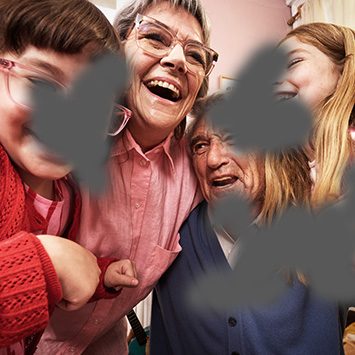
Wet age-related macular degeneration (wet AMD) is an eye condition which impacts how clearly you see. This can make everyday life challenging.
Explore the links below to find out more.
How wet AMD affects your eye

Blood vessels grow abnormally in the eye

These damaged blood vessels then leak fluid into the macula - the part of the eye that controls sharp vision

The macula swells, leading to blurred vision and vision loss



How wet AMD affects your vision
Slide to see how your vision is impacted:
How to manage wet AMD
Traditional treatments for wet AMD may involve frequent injections, taking time away from your day. These injections may also be a daunting experience for some.
But what would it mean if you could preserve your vision with less frequent treatment?*
If your retina specialist determines that it is necessary, you may need an anti-VEGF injection in the gel-like part of the SUSVIMO-treated eye (intravitreal) before your next refill.
Ask your retina specialist if you have questions about your condition or treatment options
It's time for a different treatment experience with SUSVIMO®
WANT TO CHECK YOUR VISION?
WANT TO CHECK YOUR VISION?
Follow the steps on the Amsler grid to check whether you see blurry, distorted, or wavy lines, missing corners, and dark or blank spots.
-
-
SUSVIMO [package insert]. South San Francisco, CA: Genentech, Inc; 2022.
SUSVIMO [package insert]. South San Francisco, CA: Genentech, Inc; 2022.
-
Campochiaro PA, Marcus DM, Awh CC, et al. The port delivery system with ranibizumab for neovascular age-related macular degeneration. Ophthalmology. 2019;126:1141-1154.
Campochiaro PA, Marcus DM, Awh CC, et al. The port delivery system with ranibizumab for neovascular age-related macular degeneration. Ophthalmology. 2019;126:1141-1154.
-
SUSVIMO Initial Fill and Implant Procedure Instructions for Use. Genentech, Inc. 2022.
SUSVIMO Initial Fill and Implant Procedure Instructions for Use. Genentech, Inc. 2022.
-
Monés J, Gune S, Maia M, et al. Pharmacokinetic profile of the port delivery system with ranibizumab in the phase 3 Archway trial. Presented at 21st EURETINA Congress, September 9-12, 2021.
Monés J, Gune S, Maia M, et al. Pharmacokinetic profile of the port delivery system with ranibizumab in the phase 3 Archway trial. Presented at 21st EURETINA Congress, September 9-12, 2021.
-
Ranade SV, Wieland MR, Tam T, et al. The port delivery system with ranibizumab: a new paradigm for long-acting retinal drug delivery. Drug Delivery. 2022;29(1):1326-1334.
Ranade SV, Wieland MR, Tam T, et al. The port delivery system with ranibizumab: a new paradigm for long-acting retinal drug delivery. Drug Delivery. 2022;29(1):1326-1334.
-
Data on file. Genentech, Inc. 2021.
Data on file. Genentech, Inc. 2021.
-
Data on file. Genentech, Inc. 2021.
Data on file. Genentech, Inc. 2021.
-
Holekamp NM, Campochiaro PA, Chang MA, et al; Archway Investigators. Archway randomized phase 3 trial of the port delivery system with ranibizumab for neovascular age-related macular degeneration. Ophthalmology. 2022;129(3):295-307.
Holekamp NM, Campochiaro PA, Chang MA, et al; Archway Investigators. Archway randomized phase 3 trial of the port delivery system with ranibizumab for neovascular age-related macular degeneration. Ophthalmology. 2022;129(3):295-307.
-
A phase III study to evaluate the port delivery system with ranibizumab compared with monthly ranibizumab injections in participants with wet age-related macular degeneration. ClinicalTrials.gov identifier: NCT03677934. Updated July 22, 2021. https://clinicaltrials.gov/ct2/show/NCT03677934
A phase III study to evaluate the port delivery system with ranibizumab compared with monthly ranibizumab injections in participants with wet age-related macular degeneration. ClinicalTrials.gov identifier: NCT03677934. Updated July 22, 2021. https://clinicaltrials.gov/ct2/show/NCT03677934
-
Wykoff CC; Archway Investigators. 2-year outcomes from the phase 3 Archway trial: management of neovascular age-related macular degeneration using the port delivery system with ranibizumab (PDS). Presented at Bascom Palmer Eye Institute Angiogenesis, Exudation, and Degeneration 2022 – Virtual Edition, February 11-12, 2022.
Wykoff CC; Archway Investigators. 2-year outcomes from the phase 3 Archway trial: management of neovascular age-related macular degeneration using the port delivery system with ranibizumab (PDS). Presented at Bascom Palmer Eye Institute Angiogenesis, Exudation, and Degeneration 2022 – Virtual Edition, February 11-12, 2022.
-
Data on file. Genentech, Inc. 2021.
Data on file. Genentech, Inc. 2021.
-
Data on file. Genentech, Inc. 2021.
Data on file. Genentech, Inc. 2021.
-
Chang MA, Kapre A, Kaufman D, et al. Patient preference and treatment satisfaction with a port delivery system for ranibizumab vs intravitreal injections in patients with neovascular age-related macular degeneration: a randomized clinical trial. JAMA Ophthalmology. Published online June 16, 2022.
Chang MA, Kapre A, Kaufman D, et al. Patient preference and treatment satisfaction with a port delivery system for ranibizumab vs intravitreal injections in patients with neovascular age-related macular degeneration: a randomized clinical trial. JAMA Ophthalmology. Published online June 16, 2022.
-
-
















